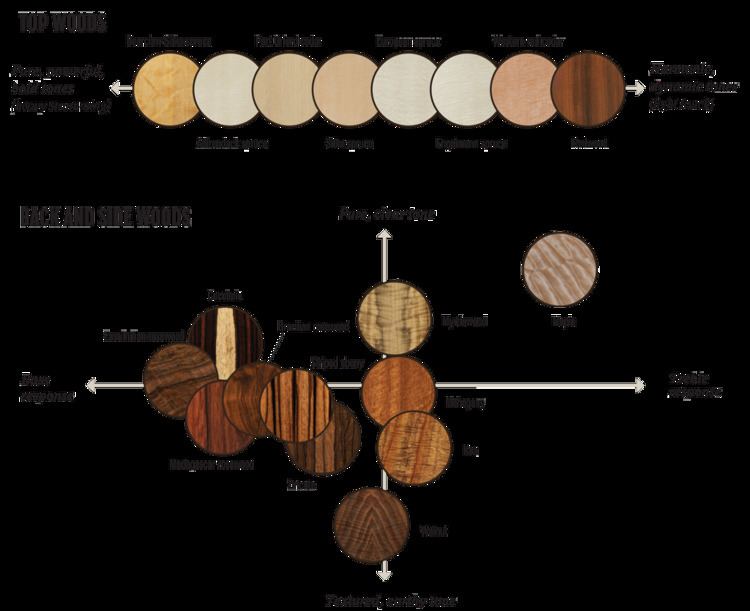Tonewood refers to specific wood varieties that possess tonal properties that make them good choices for use in acoustic stringed instruments.
As a rough generalization it can be said that stiff-but-light softwoods are favored for the soundboards or soundboard-like surface that transmits the vibrations of the strings to the ambient air. Hardwoods are favored for the body or framing element of an instrument.
Spruces are often used in the sound boards of instruments from the lute, violin, oud, mandolin, guitar, and harpsichord families; as well as the piano. Spruce is particularly suited for this use because of its high stiffness-to-weight ratio. Commonly used varieties are Sitka (or Alaskan) spruce (Picea sitchensis), Adirondack (or Red) spruce (Picea rubens), Engelmann spruce (Picea engelmannii), and Picea abies (variously known as Norwegian, German, Alpine, Italian or European spruce).Cedars, particularly Western Redcedar (Thuja plicata, not a true cedar), have since the 1950s been used in the tops of classical guitars and to a less degree in steel string acoustic guitars.Yew was once widely used for lute bowls.Other softwoods, such as redwood and Douglas fir have been used to a limited degree.Maple is traditionally used for the backs and sides of violin family instruments. It is also frequently seen in acoustic guitars and mandolins. Most Fender electric guitars feature maple necks (it is one of the hardest and most stable tonewoods, so it is often used in the neck because of its ability to withstand high tension). Variations of maple (commonly maple wood with flamed or quilted grains) are used on the tops of electric guitars for aesthetic purposes. The very sturdy frame of the modern piano is usually made of maple or of beech.Mahogany may be used in the tops of some guitars as well as the back, sides, and necks of instruments of the mandolin and guitar families. Mahogany may also be used for the solid bodies of electric guitars, such as the Gibson Les Paul. Due to lack of availability other similar woods are used as mahogany replacements, such as Toona, Khaya, Meranti, Agathis, Nato wood and Sapele. Some of these alternatives are Mahogany family timbers.Rosewoods are often used in the back and/or sides of guitars and mandolins and fretboards on guitars. The most sought-after variety, Brazilian Rosewood, Dalbergia nigra, has become scarce and expensive due to severe trade restrictions (embargo and CITES), scarcity and demand. The most widely used rosewood used now is east Indian Rosewood, often paired with a spruce top for steel string guitars and with spruce or cedar for classical guitars.Koa is traditionally used for ukuleles. Koa is also used for steel string guitars mostly due to its beauty and compressed dynamic range.Ebony is also often used in many types of instruments for fingerboards, tailpieces, tuning pegs, and so forth due to its attractive appearance, smoothness to the touch, hardness and wear resistance. Several varieties of ebony are used. Ebony is often dyed to make it appear more uniformly black than the natural wood, which sometimes shows brown streaks.Cocobolo used in upper-end clarinets and guitars.Blackwood (Tasmanian/Australian).Walnut is often used for the backs and sides of guitars and mandolin family instruments.Ash, Alder and Basswood are commonly used for the bodies of electric guitars.In addition to perceived differences in acoustic properties, a luthier may use a tonewood because of:
AvailabilityStabilityCosmetic properties such as the color or grain of the woodTraditionSize (Some instruments require large pieces of suitable wood)Tonewood choices vary greatly among different instrument types. Guitar makers generally favor quartersawn wood because it provides added stiffness and dimensional stability. Soft woods, like spruce, may be split rather than sawn into boards so the board surface follows the grain as much as possible, thus limiting run-out.
For most applications, wood must be dried before use, either in air or kilns. Some luthiers prefer further seasoning for several years. Some guitar manufacturers rarefy the wood, which mimics the natural aging process of tonewoods. Torrefaction also is used but often changes the cosmetic properties of the wood.

